The model was part of the well-built series of fixed-lens, leaf-shuttered Konica 35mm rangefinder cameras that started off with the Konica (later known as the Konica I or Konica Standard) in 1950 and ended with the Konica IIIM in 1959.
The Konica (later known as the Konica I or Konica Standard) is a knob-wound camera with a single eyepiece for the coupled rangefinder and viewfinder and comes with a retractable Konishiroku 50mm 1:3,5 lens and a Konirapid shutter with speeds from 1 to 1/500 second, and B.
The Konica II, introduced in 1951, was an improved version. The retractable Hexanon lens is now a 50mm f/2.8 unit, coupled to a Konirapid-S shutter (T, B, 1–500). The camera is also fitted with an accessory cold shoe, a shutter release button on top of the camera, and comes with a body trimmed with a curvaceous bright metal bezel surrounding the shutter/lens assembly.
The follow-up Konica II B, built from the same mold, is said to be a lower-priced version of the Konica II and came fitted with a Konirapid-S shutter and a Konishiroku Hexar 50mm 1:3.5 (from May 1955) or f/2.8 (from June 1955). The camera is missing the Time mode option with the I/T knob, as seen on the II is replaced by a round cover marked Konica B. The lens is still the fixed, rigid, collapsible mushroom head, and the focusing tab is rotated downward to extend the lens
Basic Camera Features
Unique to the Konica II B is a super bright viewfinder and rangefinder patch that is hard to match when compared to other vintage cameras, the same as what the Konica II and Konica III rangefinders are well known for.
An elegant and well-balanced design, very advanced for its time, with a curvaceous body panel design that mimics the outline of the hands when the camera is held up to your eyes. The front panel is populated by the retractable lens assembly, which is brought into focus by rotating the Focusing Lever in the clockwise or anti-clockwise direction. The lever is located on the lower part of the lens assembly base.
On the frontmost of the mushroom-headed lens assembly is the shutter speed dial, behind which are the Shutter Cock button (vertically top), Shutter Release button (left at 9 o'clock), and Aperture Ring button (right at 4 o'clock).
On the top plate area of the front panel are the viewfinder and rangefinder parallax windows.
On the top plane, from left to right, the Film Rewind knob, integrated with the Film Indicator dial, Accessory Shoe, Shutter Release button, and the Film Forward knob, integrated with the Film Counter dial.
On the backplane of the camera, just the Viewfinder Eyepiece on the back of the top plane, and a plain hinged filmback. The film back release lock is located within the Film Back Lock Knob, located on the bottom plane of the camera.
On the bottom plane, from left to right, are the Film Rewind Release button, the Tripod Socket, and the Film Back Lock Knob.
The film box is a straightforward film load system with the film canister chamber, shutter window, film forward sprocket gear, and multi-slot take-up spool, configured from left to right. The film is wound emulsion side up.
Film Loading and Rewinding
Start by opening the filmback by first turning the Lock Knob located on the bottom plane of the camera from its closed position "C' to open position "O" and pressing the small latch lock located within the indent of the Lock Knob.
Next, pull the Rewind Knob up from its resting position on the top plane of the camera, place the film cartridge in the chamber, and push the Rewind Knob back into position to secure the placement of the film cartridge. Next, pull the film tab across the film box opening, insert the tab end into the slit of the take-up spool, tension the film properly across the back, and make sure that the perforation is aligned with the sprocket gear before snapping the film back close.
Do a two-blank shot sequence to forward the unexposed part of the film to align with the shutter window. Next, reset the film counter to '0' (press the rewind release button and turn the film forward knob to set this), and you are ready to go.
To rewind the film back into its canister, first press and hold the film rewind release button, and start turning the film rewind knob in the direction indicated by the arrow (clockwise) until the film is fully wound back into the canister. Open the film back to unload the film canister for processing.
Viewfinder Readout
The viewfinder is a single bright frame eyepiece with the rangefinder parallax patch located centrally within the image frame. A reminder feature you would want to note is that the Shutter Cock lever is visible within the viewfinder when the shutter is uncocked.
Rangefinder Focusing
Focusing on the rangefinder on the Konica II B is chic, fast, and easy, and the super-bright viewfinder makes the camera a great choice that is very convenient to use.
Shutter Release on the Konica II B
The Konica II B has a Shutter Release Button on the top plane of the camera, and a Shutter Cocking Lever vertically up on the fore of the lens mount where the shutter speed ring is located. On the same plane as the Shutter Cocking Lever, at 9 o'clock, is the Shutter Release Trigger.
Shutter release on the Konica II B can be activated once the Shutter Cocking lever is cocked, and released (or accidentally released) by pushing down on the Shutter Release Trigger, or, procedurally, by pressing the Shutter Release Button on top of the camera, only if the film has been fully forwarded to the next frame.
The Shutter Release Button will remain locked if the film has not been forwarded to the next frame, and the Shutter Cocking Lever is not cocked.
To take advantage of the situation, double or multiple exposures can be achieved by cocking and releasing the shutter by using the Shutter Cocking Lever and Shutter Release Trigger repeatedly without forwarding the film.
Or you can be equally dismayed by the situation where the shutter is released accidentally by pushing down on the Shutter Release Trigger before forwarding the film to a fresh frame, meaning that, in this case, you will have an accidental double-exposure image or images on one or more of your film frames.
In Use
The Konica II B is a fully manual camera, and it does not need a battery to run any of its functions. There is not even a film ISO dial for the film speed setting, hence the only source of exposure information for the camera shutter speed/aperture setting has to be from an external light meter (with an app installed on your smartphone), or by relying manually on the Sunny 16 Rule, the method of estimating correct daylight exposures without a light meter in photography.
As an example, on a clear, sunny day, when you are using an aperture of 1:16, this rule recommends a shutter speed equal to the reciprocal of your film ISO (1/ISO) speed value. So, when using ISO 100 film, use a shutter speed of 1/100th of a second, and use a shutter speed of 1/200 second when using ISO 200 film.
Camera Body Weight
The Konica II B's body weight, on my kitchen scale, is a solid 681 grams without film. The camera does not have a strap for shoulder straps, so carrying the camera around is best in its own leather case, or, in a makeshift condition, a container pouch of your own.

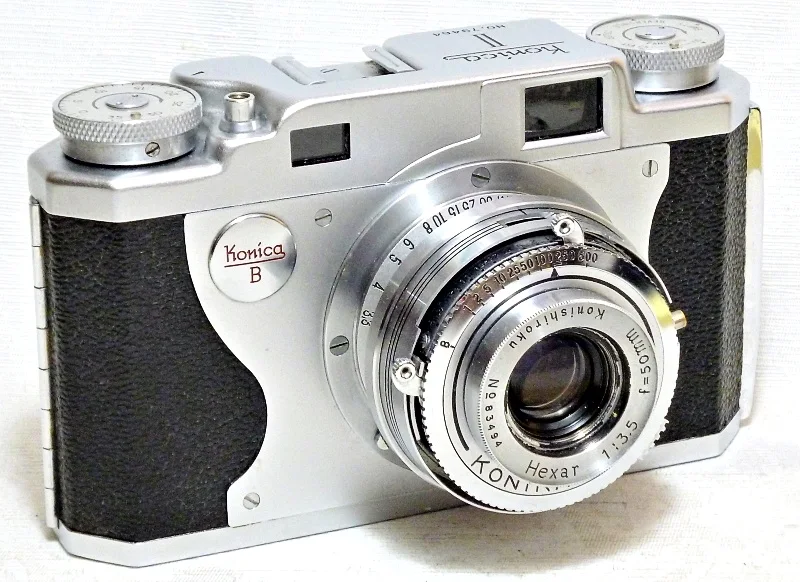



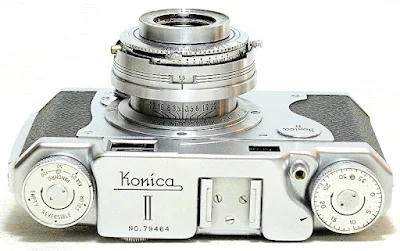
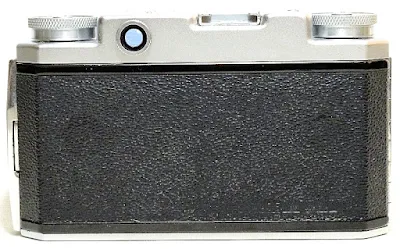
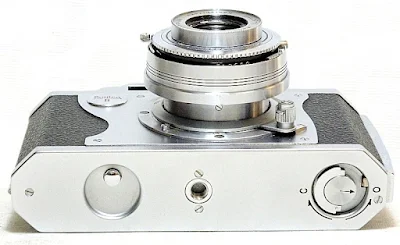
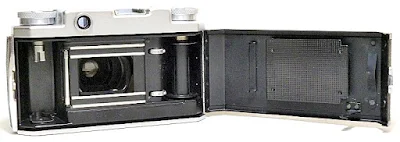
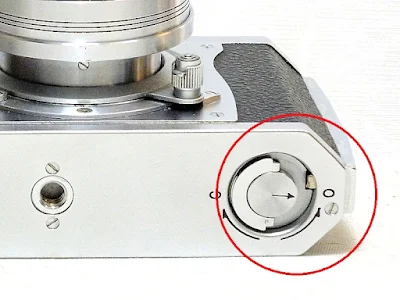
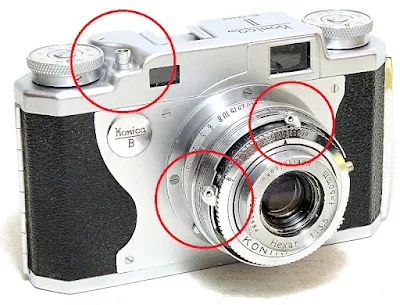











Exquisite is the word. These cameras are massively under-valued in today's market.
ReplyDelete